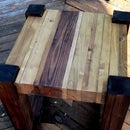Introduction: South Florida Soil Building With Mulch
It's hot and humid in south Florida. PERFECT!
This is an overview on how to make new soil in south Florida.
This video illustrates the result of two years of fun work. Replacing the ugly, traditional grass and sugar sand with plants of all kinds and tons of mulch repeatedly. This was a low cost, highly sustainable approach to creating good soil without buying it.
Additionally, the heat and humidity make it an ideal place to create soil quickly and efficiently with almost no expense (but lots of moving mulch into place, so free is relative).
Step 1: Equipment
There are a few pieces of equipment needed:
A wheelbarrow or something to move the mulch in.
Get a dust mask if you are sensitive to mushroom spores (if moving the mulch within the first month of it being dropped).
A flat shovel for shearing the soil seasonally.
Cardboard (I get mine from behind Pier 1, they have huge boxes and I can usually get what I need in one stop. I ask the manager once for permission and get some whenever I need it.)
Step 2: The Overview on How to Create Soil for Almost Free
Acquire Mulch. Tree trimmers are always ready to drop off a batch, so call around, find a local trimmer and give them clear instructions where to drop the mulch. Always get much more mulch than you think you need. You don’t need yards of if, you need truckloads of it to grow soil. (One truck load at a time!)
Step 3: Killing the Weeds With Cardboard
Put cardboard over any weedy areas and mulch over the cardboard heavily. (At least 3 inches, but I go way overboard....) Try to cover it deep enough that the sunlight will never reach the cardboard.
Step 4: Making Mountains With Mulch
Florida is mostly FLAT land. So I'm making my own little mountains with mulch! Put heaping piles of mulch in the walkways (within reason for safety) and anytime it gets flat, add a bit more. Add it to plant beds to keep the weeds down, as thick as you can (again, use cardboard in trouble areas). Give a little space around plants that may rot if they come into contact with the mulch, but I usually just pile it on and most of the plants seem to work well with it.
Step 5: Harvesting the Young Soil
Twice a year (or more), sweep aside the mulch in the walkways and find that dark, young, mucky soil hiding underneath. Use a flat shovel and shear off the top soil and put it in the beds (sometimes you may need to break it up). Don’t go too deep, just the top dark layer.
Put the half-cooked mulch back in the walkway and then what? Add more fresh mulch. This is essentially replacing the need for peat, which was something I was unwilling to buy because it is a non-renewable resource.
** Timing is important, but not essential **
One of the things I’ve found is that timing is important. If you can move a freshly chipped tree onto its cooking location (where it will remain for months) it will cook that much faster because it is moist and quickly form the mycelium that creates the heat and soil we are after.
I’m adding 3-6 inches of rich topsoil every year with this process for my whole yard.
Step 6: Optional Step, the Floating Walkway
You can take it a step further…. I added a wood deck over my mulch so that it is out of the sun and will cook faster. (It also makes my wife happy since she doesn’t have to wobble through as much mulch when working in the garden.)
It is a bit more work, but the wood was free and sitting around. The process is the same, except you build your mulch up and then put a floating deck over the top. Once a year I lift one set of boards, shear the topsoil and replace the deck on some heaping fresh mulch, then I repeat for the next set of boards. I will usually spray the underside of the wood with Neem Oil to help keep it from rotting away with the mulch.
Step 7: What to Do With All This Fresh Soil?
Put the freshly-harvested soil anywhere you want your plants to grow! You can put it in raised beds, planted rows or potted plants. I treat it as an amendment for established plants and you can see the growth increase within a few weeks. I will usually add some vermiculite or perlite to the new soil for aeration.
Step 8: The REAL Magic Is Sooo Tiny!
The rock-star in all this is the bacteria and mushrooms that go to work on the mulch so quickly. They may be small, but they are mighty and with a little bit of help they can do the work so much faster than you would expect.
Step 9: The Versatility of Mulch
One last note. There is another exciting thing you can do with mulch. You can create free hot water! Low/no cost options for hot water or priming your hot water heater with warm water to save on the electric bill can cut your hot water bill my MORE than half!
If you want to learn more about this subscribe to my newsletter, it's free and you can unsubscribe if I irritate you. Sign up here.
Thanks for reading and I hope this helps you think and be more sustainable everyday!






